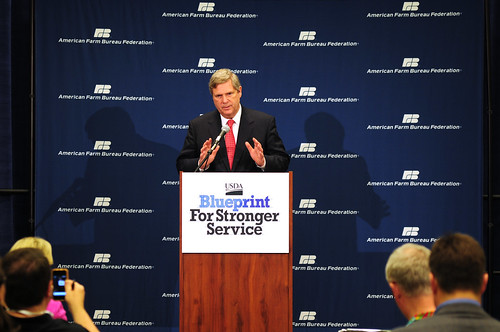
Today at the American Farm Bureau Federation’s 93rd Annual Meeting, I thanked about 10,000 farmers for helping to make U.S. agriculture a bright spot in our nation’s economy.
In the past few decades, U.S. agriculture has become the second most productive sector of the American economy, thanks to farmers adopting technology, reducing debt, and effectively managing risk. In 2011, America’s farmers, ranchers and producers achieved record farm income, record exports, and have helped to contribute to an unemployment figure in rural America that has fallen faster than in other parts of the country. Over the last three years, as USDA has made significant investments in rural America, we have also looked closely at the way we do business so that we are sustaining and enhancing the farm economy for generations to come. That is why today I introduced USDA’s Blueprint for Stronger Service—a plan that will help to preserve this success in the long term.
The Blueprint for Stronger Service takes a realistic view of the needs of American agriculture in a challenging budget climate, and lays out USDA’s plans to modernize and accelerate service delivery while improving the customer experience through use of innovative technologies and business solutions. To manage the $3 billion—or 12 percent—reduction Congress has made to discretionary funding for the Department since 2010, USDA looked closely at the way we do business. For example, some agencies put hiring controls in place and instituted early separation programs. These efforts, when coupled with regular retirement, meant nearly 7,000 employees have retired from USDA over the past 15 months. The plan is also part of the Administration’s Campaign to Cut Waste, launched by President Obama and Vice President Biden to make government work better and more efficiently for the American people. The end result is a plan that will create optimal use of USDA’s employees, better results for USDA customers, and greater efficiencies for American taxpayers.
The USDA, like families and businesses across the country, cannot continue to operate like we did 50 years ago. We must innovate, modernize, and be better stewards of the taxpayers’ dollars. We must be built to meet the evolving needs of a 21st century agricultural economy.
When fully implemented, the recommendations included in the Blueprint for Stronger Service will provide efficiencies valued at about $150 million annually—and eventually more based on future realignment of the workforce—and will ensure that USDA continues to provide optimal service to the American people within available funding levels.
A Blueprint for Stronger Service details a list of 133 recommendations that affirm processes already in place, as well as 27 initial improvements, and others aimed at longer-term improvements. The initial recommendations include the following:
- Consolidate more than 700 cell phone plans into about 10;
- Standardize civil rights training and purchases of cyber security products;
- Ensure more efficient and effective service to our employees by moving toward more centralized civil rights, human resource, procurement, and property management functions, creating millions of dollars in efficiencies without sacrificing the quality of our work.
Budget reductions, staff attrition and increased workload also necessitated a review of USDA facilities, offices and lab operations across the country. As a result, USDA will close 259 domestic offices, facilities and labs across the country, as well as seven foreign offices. In some cases, offices are no longer staffed or have a very small staff of one or two people; many are within 20 miles of other USDA offices. In other cases, technology improvements, advanced service centers, and broadband service have reduced some need for brick and mortar facilities.
American agriculture is currently experiencing its most productive period in history thanks to the resiliency, resourcefulness and efficiency of our farmers, ranchers and producers. As we move forward, USDA will continue to find ways to modernize its services, improve the customer experience, and ensure a successful, sustainable future for rural America.
